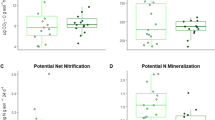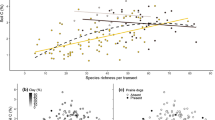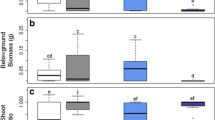Abstract
Aims
As woody plants encroach into grassland ecosystems, we expect altered plant-soil interactions to change the microbial processes that affect soil carbon storage and nutrient cycling. Specifically, this research aimed to address how (1) soil chemistry, (2) microbial nutrient demand, and (3) the rate and source of potential soil C mineralization vary spatially under clonal woody shrubs of varying size within a mesic grassland.
Methods
We collected soil samples from the center, the midpoint between the center and edge, the edge, and the shrub-grass ecotone of multiple Cornus drummondii shrubs across a shrub-size gradient in infrequently burned tallgrass prairie.
Results
Total soil carbon and nitrogen increased with shrub size at every sampling location but the edge. Microbial demand for nitrogen also increased as shrubs increased in size. Across all shrub sizes and sampling locations, potential soil carbon mineralization rates were higher when microbes broke down proportionally more shrub-derived (C3) organic matter than grass-derived (C4) organic matter.
Conclusions
Our results suggest that the spatio-temporal context of woody encroachment is critical for understanding its impact on belowground microbial processes. In this ecosystem, a longer period of occupancy by woody plants increases potentially mineralizable soil carbon.





Similar content being viewed by others
Abbreviations
- C:
-
carbon
- N:
-
nitrogen
- P:
-
phosphorus
- BG:
-
β-glucosidase
- NAG:
-
N-acetyl-glucosaminidase
- PHOS:
-
phosphatase
- LAP:
-
leucine-aminopeptidase
References
Allison SD, Vitousek PM (2005) Responses of extracellular enzymes to simple and complex nutrient inputs. Soil Biol Biochem 37:937–944. https://doi.org/10.1016/j.soilbio.2004.09.014
Archer SR, Andersen EM, Predick KI, Schwinning S, Steidl RJ, Woods SR (2017) Woody plant encroachment: causes and consequences. In: Briske DD (ed) Rangeland systems: processes. Management and Challenges. Springer International Publishing, Cham, pp 25–84
Bai E, Boutton TW, Liu F, Ben Wu X, Archer SR (2012) Spatial patterns of soil δ 13C reveal grassland-to-woodland successional processes. Org Geochem 42:1512–1518. https://doi.org/10.1016/j.orggeochem.2010.11.004
Barger NN, Archer SR, Campbell JL, et al (2011) Woody plant proliferation in north American drylands: a synthesis of impacts on ecosystem carbon balance. J Geophys Res Biogeosciences 116:G00K07. https://doi.org/10.1029/2010JG001506
Bates D, Mächler M, Bolker B, Walker S (2015) Fitting linear mixed-effects models using {lme4}. J Stat Softw 67:1–48. https://doi.org/10.18637/jss.v067.i01
Blagodatskaya E, Yuyukina T, Blagodatsky S, Kuzyakov Y (2011) Turnover of soil organic matter and of microbial biomass under C3-C4 vegetation change: consideration of 13C fractionation and preferential substrate utilization. Soil Biol Biochem 43:159–166. https://doi.org/10.1016/j.soilbio.2010.09.028
Blair JM, Nippert J, Briggs J (2014) Grassland ecology. In: Monson RK (ed) Ecology and the environment. Springer New York, New York, pp 389–423
Blaser WJ, Shanungu GK, Edwards PJ, Olde Venterink H (2014) Woody encroachment reduces nutrient limitation and promotes soil carbon sequestration. Ecol Evol 4:1423–1438. https://doi.org/10.1002/ece3.1024
Bolling JD, Walker LR (2002) Fertile island development around perennial shrubs across a Mojave Desert chronosequence. West North Am Nat 62:88–100. https://doi.org/10.1016/j.jaridenv.2007.11.004
Bouma TJ, Yanai RD, Elkin AD, Hartmond U, Flores-Alva DE, Eissenstat DM (2001) Estimating age-dependent costs and benefits of roots with contrasting life span: comparing apples and oranges. New Phytol 150:685–695. https://doi.org/10.1046/j.1469-8137.2001.00128.x
Bremmer JM, Keeney DR (1966) Determination and isotope-ratio analysis of different forms of nitrogen in soils: 3. Exchangeable ammonium, nitrate, and nitrite by extraction-distillation methods. Soil Sci Soc Am J 30:577–582. https://doi.org/10.2136/sssaj1966.03615995003000050015x
Briggs JM, Knapp AK, Brock BL (2002) Expansion of woody plants in tallgrass prairie: a fifteen-year study of fire and fire-grazing interactions. Am Midl Nat 147:287–294. https://doi.org/10.1674/0003-0031
Briggs JM, Knapp AK, Blair JM et al (2005) An ecosystem in transition:cause and consequences of the conversion of Mesic grassland to shrubland. Bioscience 55:561–572. https://doi.org/10.1641/0006-3568(2005)055
Cabrera ML, Beare MH (1993) Alkaline persulfate oxidation for determining total nitrogen in microbial biomass extracts. Soil Sci Soc Am J 57:1007–1012. https://doi.org/10.2136/sssaj1993.03615995005700040021x
Canadell J, Jackson RB, Ehleringer JB, Mooney HA, Sala OE, Schulze ED (1996) Maximum rooting depth of vegetation types at the global scale. Oecologia 108:583–595. https://doi.org/10.1007/BF00329030
Case MF, Wigley BJ, Wigley-Coetsee C, Carla Staver A (2020) Could drought constrain woody encroachers in savannas? African J Range Forage Sci 37:19–29. https://doi.org/10.2989/10220119.2019.1697363
Casper BB, Jackson RB (1997) Plant competition underground. Annu Rev Ecol Syst 28:545–570. https://doi.org/10.1038/337122a0
Coetsee C, Bond WJ, February EC (2010) Frequent fire affects soil nitrogen and carbon in an African savanna by changing woody cover. Oecologia 162:1027–1034. https://doi.org/10.1007/s00442-009-1490-y
Combs SM, Nathan M V. (1998) Soil organic matter. In: Recommended chemical soil test procedures for the north central region. Missouri Ag. Exp. Stn. SB 1001., Colombia, MO, pp 53–58
Connell RK, Nippert JB, Blair JM (2020a) Three decades of divergent land use and plant community change alters soil C and N content in tallgrass prairie. J Geophys Res Biogeosciences 125:e2020JG005723. https://doi.org/10.1029/2020JG005723
Connell RK, O’Connor R, Nippert JB, Blair JM (2020b) SMP01 spatial variation of soil microbial processes under Cornus drummondii shrubs of varying size at Konza prairie, 2017. https://doi.org/10.6073/pasta/a3d1dd8467448064c258103d7ed18714
Creamer CA, Filley TR, Boutton TW, Oleynik S, Kantola IB (2011) Controls on soil carbon accumulation during woody plant encroachment: evidence from physical fractionation, soil respiration, and δ13C of respired CO2. Soil Biol Biochem 43:1678–1687. https://doi.org/10.1016/J.SOILBIO.2011.04.013
D’Elia CF, Steudler PA, Corwin N (1977) Determination of total nitrogen in aqueous samples using persulfate digestion1. Limnol Oceanogr 22:760–764. https://doi.org/10.4319/lo.1977.22.4.0760
Derner JD, Briske DD, Boutton TW (1997) Does grazing mediate soil carbon and nitrogen accumulation beneath C4, perennial grasses along an environmental gradient? Plant Soil 191:147–156. https://doi.org/10.1023/A:1004298907778
Eldridge DJ, Wong VNL (2005) Clumped and isolated trees influence soil nutrient levels in an Australian temperate box woodland. Plant Soil 270:331–342. https://doi.org/10.1007/s11104-004-1774-2
Eldridge DJ, Bowker MA, Maestre FT, Roger E, Reynolds JF, Whitford WG (2011) Impacts of shrub encroachment on ecosystem structure and functioning: towards a global synthesis. Ecol Lett 14:709–722. https://doi.org/10.1111/j.1461-0248.2011.01630.x
February EC, Higgins SI (2010) The distribution of tree and grass roots in savannas in relation to soil nitrogen and water. South African J Bot 76:517–523. https://doi.org/10.1016/j.sajb.2010.04.001
February E, Pausch J, Higgins SI (2020) Major contribution of grass roots to soil carbon pools and CO2 fluxes in a Mesic savanna. Plant Soil 454:207–215. https://doi.org/10.1007/s11104-020-04649-3
Fox J, Weisberg S (2019) An {R} companion to applied regression, third. Sage, thousand oaks {CA}
Garner W, Steinberger Y (1989) A proposed mechanism for the formation of “fertile islands” in the desert ecosystem. J Arid Environ 16:257–262. https://doi.org/10.1016/s0140-1963(18)30941-8
German DP, Weintraub MN, Grandy AS, Lauber CL, Rinkes ZL, Allison SD (2011) Optimization of hydrolytic and oxidative enzyme methods for ecosystem studies. Soil Biol Biochem 43:1387–1397. https://doi.org/10.1016/j.soilbio.2011.03.017
Hishi T (2007) Heterogeneity of individual roots within the fine root architecture: causal links between physiological and ecosystem functions. J For Res 12:126–133. https://doi.org/10.1007/s10310-006-0260-5
Hishi T, Takeda H (2005) Dynamics of heterorhizic root systems: protoxylem groups within the fine-root system of Chamaecyparis obtusa. New Phytol 167:509–521. https://doi.org/10.1111/j.1469-8137.2005.01418.x
Hothorn T, Bretz F, Westfall P (2008) Simultaneous inference in general parametric models. Biom J 50:346–363. https://doi.org/10.1002/bimj.200810425
Jackson RB, Caldwell MM (1993) Geostatistical patterns of soil heterogeneity around individual perennial plants. J Ecol 81:683–692. https://doi.org/10.2307/2261666
Jackson RB, Mooney HA, Schulze ED (1997) A global budget for fine root biomass, surface area, and nutrient contents. Proc Natl Acad Sci U S A 94:7362–7366. https://doi.org/10.1073/pnas.94.14.7362
Jackson RB, Banner JL, Jobbágy EG, Pockman WT, Wall DH (2002) Ecosystem carbon loss with woody plant invasion of grasslands. Nature 418:623–626. https://doi.org/10.1038/nature00910
Jenkinson DS, Powlson DS (1976) The effects of biocidal treatments on metabolism in soil—I. fumigation with chloroform. Soil Biol Biochem 8:167–177. https://doi.org/10.1016/0038-0717(76)90001-8
Knapp AK, Briggs JM, Collins SL et al (2008) Shrub encroachment in north American grasslands: shifts in growth form dominance rapidly alters control of ecosystem carbon inputs. Glob Chang Biol 14:615–623. https://doi.org/10.1111/j.1365-2486.2007.01512.x
Kulmatiski A, Beard KH, Holdrege MC, February EC (2020) Small differences in root distributions allow resource niche partitioning. Ecol Evol 10:9776–9787. https://doi.org/10.1002/ece3.6612
Kuzyakov Y (2006) Sources of CO2 efflux from soil and review of partitioning methods. Soil Biol Biochem 38:425–448. https://doi.org/10.1016/j.soilbio.2005.08.020
Lehmann J, Solomon D, Kinyangi J, Dathe L, Wirick S, Jacobsen C (2008) Spatial complexity of soil organic matter forms at nanometre scales. Nat Geosci 1:238–242. https://doi.org/10.1038/ngeo155
Lenth R V (2016) Least-squares means: the {R} package {lsmeans}. J stat Softw 69:1–33. https://doi.org/10.18637/jss.v069.i01
Lett MS, Knapp AK, Briggs JM, Blair JM (2004) Influence of shrub encroachment on aboveground net primary productivity and carbon and nitrogen pools in a Mesic grassland. Can J Bot 82:1363–1370. https://doi.org/10.1139/b04-088
Li PX, Wang N, He WM, Krüsi BO, Gao SQ, Zhang SM, Yu FH, Dong M (2008) Fertile islands under Artemisia ordosica in inland dunes of northern China: effects of habitats and plant developmental stages. J Arid Environ 72:953–963. https://doi.org/10.1016/j.jaridenv.2007.11.004
Li H, Shen H, Chen L, Liu T, Hu H, Zhao X, Zhou L, Zhang P, Fang J (2016) Effects of shrub encroachment on soil organic carbon in global grasslands. Sci Rep 6:28974. https://doi.org/10.1038/srep28974
Liao JD, Boutton TW, Jastrow JD (2006) Storage and dynamics of carbon and nitrogen in soil physical fractions following woody plant invasion of grassland. Soil Biol Biochem 38:3184–3196. https://doi.org/10.1016/J.SOILBIO.2006.04.003
Logan KE, Brunsell NA (2015) Influence of drought on growing season carbon and water cycling with changing land cover. Agric For Meteorol 213:217–225. https://doi.org/10.1016/J.AGRFORMET.2015.07.002
Lüdecke D (2018) Ggeffects: tidy data frames of marginal effects from regression models. J Open Source Softw 3:772. https://doi.org/10.21105/joss.00772
Ludwig JA, Wilcox BP, Breshears DD, Tongway DJ, Imeson AC (2005) Vegetation patches and runoff-erosion as interacting ecohydrological processes in semiarid landscapes. Ecology 86:288–297. https://doi.org/10.1890/03-0569
Matlack RS, Kaufman DW, Kaufman GA (2008) Influence of woody vegetation on small mammals in tallgrass prairie. Am Midl Nat 160:7–19. https://doi.org/10.1674/0003-0031(2008)160[7:IOWVOS]2.0.CO;2
McCulley RL, Jackson RB (2012) Conversion of tallgrass prairie to woodland: consequences for carbon and nitrogen cycling. Am Midl Nat 167:307–321. https://doi.org/10.1674/0003-0031-167.2.307
McKee GA, Soong JL, Caldéron F et al (2016) An integrated spectroscopic and wet chemical approach to investigate grass litter decomposition chemistry. Biogeochemistry 128:107–123. https://doi.org/10.1007/s10533-016-0197-5
McKinley DC, Blair JM (2008) Woody plant encroachment by Juniperus virginiana in a Mesic native grassland promotes rapid carbon and nitrogen accrual. Ecosystems 11:454–468. https://doi.org/10.1007/s10021-008-9133-4
Mehlich A (1984) Mehlich 3 soil test extractant: a modification of Mehlich 2 extractant. Commun Soil Sci Plant Anal 15:1409–1416. https://doi.org/10.1080/00103628409367568
Moorhead LC, Souza L, Habeck CW, Lindroth RL, Classen AT (2017) Small mammal activity alters plant community composition and microbial activity in an old-field ecosystem. Ecosphere 8:e01777. https://doi.org/10.1002/ecs2.1777
Muench AT, O’Keefe K, Nippert JB (2016) Comparative ecohydrology between Cornus drummondii and Solidago canadensis in upland tallgrass prairie. Plant Ecol 217:267–276. https://doi.org/10.1007/s11258-016-0567-z
Nippert JB (2020) AWE01 meteorological data from the Konza prairie headquarters weather station. https://doi.org/10.6073/pasta/297c4e318a62b80340bba6ba5184a37d
Nippert JB, Knapp AK (2007) Soil water partitioning contributes to species coexistence in tallgrass prairie. Oikos 116:1017–1029. https://doi.org/10.1111/j.0030-1299.2007.15630.x
Nippert JB, Ocheltree TW, Orozco GL, Ratajczak Z, Ling B, Skibbe AM (2013) Evidence of physiological decoupling from grassland ecosystem drivers by an encroaching woody shrub. PLoS One 8:1–8. https://doi.org/10.1371/journal.pone.0081630
Ochoa-Hueso R, Eldridge DJ, Delgado-Baquerizo M, Soliveres S, Bowker MA, Gross N, le Bagousse-Pinguet Y, Quero JL, García-Gómez M, Valencia E, Arredondo T, Beinticinco L, Bran D, Cea A, Coaguila D, Dougill AJ, Espinosa CI, Gaitán J, Guuroh RT, Guzman E, Gutiérrez JR, Hernández RM, Huber-Sannwald E, Jeffries T, Linstädter A, Mau RL, Monerris J, Prina A, Pucheta E, Stavi I, Thomas AD, Zaady E, Singh BK, Maestre FT (2018) Soil fungal abundance and plant functional traits drive fertile island formation in global drylands. J Ecol 106:242–253. https://doi.org/10.1111/1365-2745.12871
Pellegrini AFA, Hobbie SE, Reich PB, Jumpponen A, Brookshire ENJ, Caprio AC, Coetsee C, Jackson RB (2020) Repeated fire shifts carbon and nitrogen cycling by changing plant inputs and soil decomposition across ecosystems. Ecol Monogr 00:e01409. https://doi.org/10.1002/ecm.1409
R Core Team (2019) R: A language and environment for statistical computing
Ratajczak Z, Nippert JB, Hartman JC, Ocheltree TW (2011) Positive feedbacks amplify rates of woody encroachment in Mesic tallgrass prairie. Ecosphere 2:121. https://doi.org/10.1890/ES11-00212.1
Ratajczak Z, Nippert JB, Briggs JM, Blair JM (2014) Fire dynamics distinguish grasslands, shrublands and woodlands as alternative attractors in the central Great Plains of North America. J Ecol 102:1374–1385. https://doi.org/10.1111/1365-2745.12311
Ridolfi L, Laio F, D’Odorico P (2008) Fertility island formation and evolution in dryland ecosystems. Ecol Soc 13:5. http://www.ecologyandsociety.org/vol13/iss1/art5/
Rong Q, Liu J, Cai Y, Lu Z, Zhao Z, Yue W, Xia J (2016) “Fertile island” effects of Tamarix chinensis Lour. On soil N and P stoichiometry in the coastal wetland of Laizhou Bay, China. J Soils Sediments 16:864–877. https://doi.org/10.1007/s11368-015-1296-y
Sala OE, Maestre FT (2014) Grass-woodland transitions: determinants and consequences for ecosystem functioning and provisioning of services. J Ecol 102:1357–1362. https://doi.org/10.1111/1365-2745.12326
Schenk HJ, Jackson RB (2002) Rooting depths, lateral root spreads and below-ground/above-ground allometries of plants in water-limited ecosystems. J Ecol 90:480–494. https://doi.org/10.1046/j.1365-2745.2002.00682.x
Schlesinger WH, Pilmanis AM (1998) Plant-soil interactions in deserts. Biogeochemistry 42:169–187. https://doi.org/10.1023/A:1005939924434
Schlesinger WH, Raikks JA, Hartley AE, Cross AF (1996) On the spatial pattern of soil nutrients in desert ecosystems. Ecology 77:364–374. https://doi.org/10.2307/2265615
Sinsabaugh RL, Follstad Shah JJ (2012) Ecoenzymatic stoichiometry and ecological theory. Annu Rev Ecol Evol Syst 43:313–343. https://doi.org/10.1146/annurev-ecolsys-071112-124414
Sinsabaugh RL, Klug MJ, Collins HP et al (1999) Characterizing soil microbial communities. In: Robertson GP, Bledsoe CS, Coleman DC, Sollins P (eds) Standard soil methods for long term ecological research. Oxford University Press, New York, NY, pp 476–525
Sinsabaugh RL, Carreiro MM, Repert DA (2002) Allocation of extracellular enzymatic activity in relation to litter composition, N deposition, and mass loss. Biogeochemistry 60:1–24. https://doi.org/10.1023/A:1016541114786
Sinsabaugh RL, Lauber CL, Weintraub MN, Ahmed B, Allison SD, Crenshaw C, Contosta AR, Cusack D, Frey S, Gallo ME, Gartner TB, Hobbie SE, Holland K, Keeler BL, Powers JS, Stursova M, Takacs-Vesbach C, Waldrop MP, Wallenstein MD, Zak DR, Zeglin LH (2008) Stoichiometry of soil enzyme activity at global scale. Ecol Lett 11:1252–1264. https://doi.org/10.1111/j.1461-0248.2008.01245.x
Sinsabaugh RL, Hill BH, Follstad Shah JJ (2009) Ecoenzymatic stoichiometry of microbial organic nutrient acquisition in soil and sediment. Nature 462:795–798. https://doi.org/10.1038/nature08632
Soliveres S, Eldridge DJ (2014) Do changes in grazing pressure and the degree of shrub encroachment alter the effects of individual shrubs on understorey plant communities and soil function? Funct Ecol 28:530–537. https://doi.org/10.1111/1365-2435.12196
Taylor JP, Wilson B, Mills MS, Burns RG (2002) Comparison of microbial numbers and enzymatic activities in surface soils and subsoils using various techniques. Soil Biol Biochem 34:387–401. https://doi.org/10.1016/S0038-0717(01)00199-7
Throop HL, Archer SR (2008) Shrub (Prosopis velutina) encroachment in a semidesert grassland: spatial-temporal changes in soil organic carbon and nitrogen pools. Glob Chang Biol 14:2420–2431. https://doi.org/10.1111/j.1365-2486.2008.01650.x
Wang H, Boutton TW, Xu W, Hu G, Jiang P, Bai E (2015) Quality of fresh organic matter affects priming of soil organic matter and substrate utilization patterns of microbes. Sci Rep 5:1–13. https://doi.org/10.1038/srep10102
Ward D, Trinogga J, Wiegand K, du Toit J, Okubamichael D, Reinsch S, Schleicher J (2018) Large shrubs increase soil nutrients in a semi-arid savanna. Geoderma 310:153–162. https://doi.org/10.1016/j.geoderma.2017.09.023
Wheeler CW, Archer SR, Asner GP, McMurtry CR (2007) Climatic/edaphic controls on soil carbon/nitrogen response to shrub encroachment in desert grassland. Ecol Appl 17:1911–1928. https://doi.org/10.1890/06-1580.1
Whitford WG, Anderson J, Rice PM (1997) Stemflow contribution to the “fertile island” effect in creosotebush, Larrea tridentata. J Arid Environ 35:451–457. https://doi.org/10.1006/jare.1996.0164
Wickham H (2017) `tidyverse: easily install and load the “Tidyverse”
Wigley BJ, Augustine DJ, Coetsee C, Ratnam J, Sankaran M (2020) Grasses continue to trump trees at soil carbon sequestration following herbivore exclusion in a semiarid African savanna. Ecology 101:e03008. https://doi.org/10.1002/ecy.3008
Wilke CO (2019) Cowplot: streamlined plot theme and plot annotations for “ggplot2”
Williams RJ, Hallgren SW, Wilson GWT, Palmer MW (2013) Juniperus virginiana encroachment into upland oak forests alters arbuscular mycorrhizal abundance and litter chemistry. Appl Soil Ecol 65:23–30. https://doi.org/10.1016/J.APSOIL.2012.12.020
Wynn JG, Bird MI (2007) C4-derived soil organic carbon decomposes faster than its C3 counterpart in mixed C3/C4 soils. Glob Chang Biol 13:2206–2217. https://doi.org/10.1111/j.1365-2486.2007.01435.x
Wynn JG, Duvert C, Bird MI, et al (2020) Land transformation in tropical savannas preferentially decomposes newly added biomass, whether C3 or C4 derived. Ecol Appl eap.2192. https://doi.org/10.1002/eap.2192
Zeglin LH, Myrold DD (2013) Fate of decomposed fungal cell wall material in organic horizons of old-growth Douglas-fir forest soils. Soil Sci Soc Am J 77:489–500. https://doi.org/10.2136/sssaj2012.0204
Zhou Y, Staver AC (2019) Enhanced activity of soil nutrient-releasing enzymes after plant invasion: a meta-analysis. Ecology Accepted A 100:e02830. https://doi.org/10.1002/ecy.2830
Zhou Y, Boutton TW, Ben WX (2018) Soil phosphorus does not keep pace with soil carbon and nitrogen accumulation following woody encroachment. Glob Chang Biol 24:1992–2007. https://doi.org/10.1111/gcb.14048
Acknowledgments
We thank Dr. Lydia Zeglin for her assistance with the methodology, collection, and interpretation of the potential extracellular enzymatic activity assays and Dr. Anthony Joern for providing funds for reagents. Dr. Lydia Zeglin and Emily Wedel provided feedback which greatly increased the quality of this manuscript. We also thank Aditi Arun and Paige Humphrey for their assistance in the field and lab and Emily Wedel for her artistic contributions to Fig. 5. This research was supported by the NSF Long-Term Ecological Research Program at Konza Prairie Biological Station. JBN was supported by DOE award # DE-SC0019037. This material is based upon work supported by the National Science Foundation Graduate Research Fellowship under Grant No. GGVP005607-3145-50010. Any opinions, findings, and conclusions or recommendations expressed in this material are those of the authors and do not necessarily reflect the views of the National Science Foundation. This is publication #21-141-J from the Kansas Agricultural Experiment Station. All data used in this study can be found on the Konza Prairie LTER website (Connell et al. 2020b).
Author information
Authors and Affiliations
Corresponding author
Additional information
Responsible Editor: Yolima Carrillo.
Publisher’s note
Springer Nature remains neutral with regard to jurisdictional claims in published maps and institutional affiliations.
Supplementary Information
ESM 1
(DOCX 31 kb)
Rights and permissions
About this article
Cite this article
Connell, R.K., O’Connor, R.C., Nippert, J.B. et al. Spatial variation in soil microbial processes as a result of woody encroachment depends on shrub size in tallgrass prairie. Plant Soil 460, 359–373 (2021). https://doi.org/10.1007/s11104-020-04813-9
Received:
Accepted:
Published:
Issue Date:
DOI: https://doi.org/10.1007/s11104-020-04813-9




